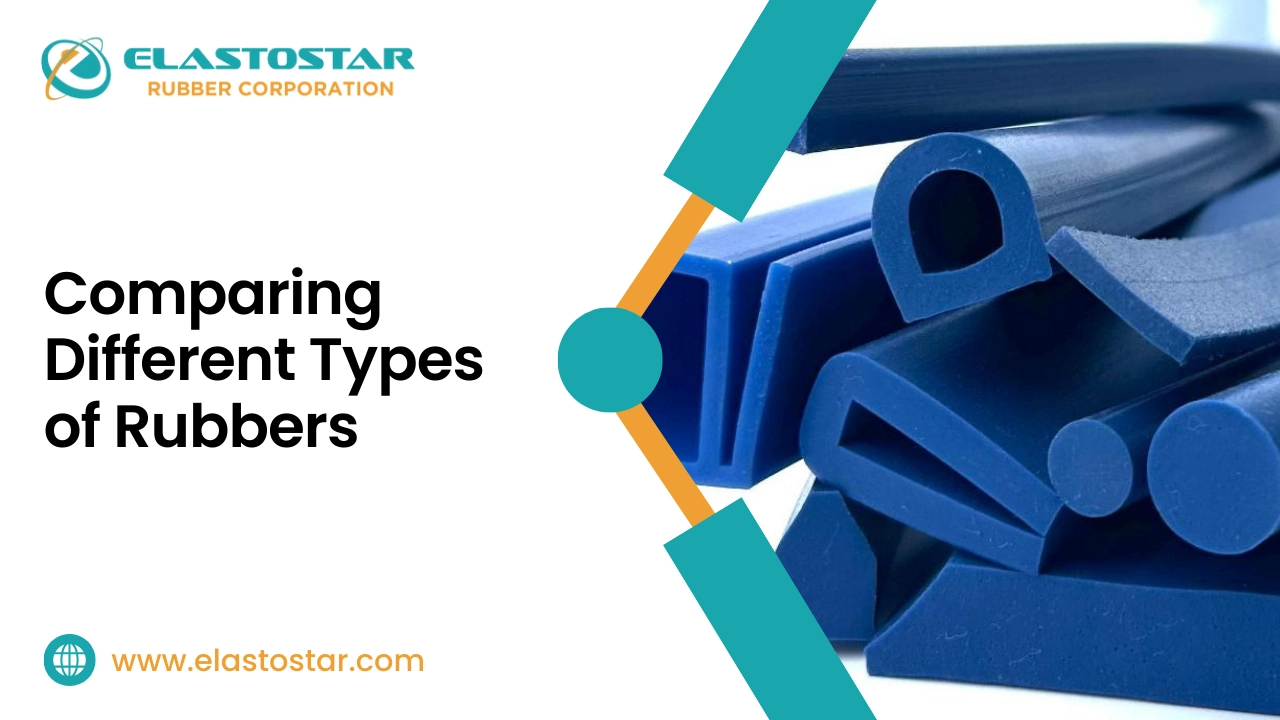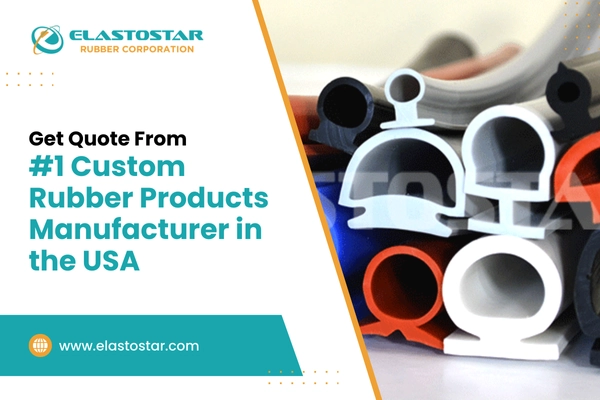Rubber is a material used in countless industries, from automotive and healthcare to construction and electronics. It comes in various types, each with unique properties that make it suitable for different applications. Natural rubber, derived from latex, is prized for its flexibility, while synthetic rubbers like nitrile and silicone rubber offer enhanced resistance to heat, chemicals, and aging. Understanding the differences between these rubbers helps in selecting the right one for your needs.
In this blog, we’ll explore the most common types of rubber, their properties, and uses, so you can make informed decisions about rubber materials.
Table of Contents
What is Rubber?

Rubber is a soft, flexible material that can stretch and return to its original shape. It is used in many industries because of its strength and durability.
There are two main types of rubber: natural rubber, which comes from the latex of rubber trees, and synthetic rubber, which is made from chemicals.
Natural rubber is very elastic, while synthetic rubber is better at resisting heat, chemicals, and aging. Rubber is used to make everyday items like tires, seals, and gaskets, as well as products for industries like healthcare, construction, and automotive.
Common Types of Rubber and Their Properties
Understanding the unique properties of different rubbers is important when selecting the right material for specific applications.
1. Natural Rubber (NR)
Natural rubber, derived from latex, is highly elastic and resilient. It is commonly used in applications requiring flexibility, such as tires and belts. It performs well in a temperature range of -20°C to 80°C and has good chemical resistance to acids and alkalis, but it is less effective against oils and heat.
2. Styrene-Butadiene Rubber (SBR)
SBR is a durable synthetic rubber widely used in tires, seals, and gaskets due to its excellent abrasion resistance. Compared to EPDM, it offers superior wear resistance but is less suitable for outdoor applications where weather resistance is essential.
3. Butyl Rubber (IIR)
Butyl rubber is known for its durability and low gas permeability, making it ideal for inner tubes, seals, and gaskets. Its flexibility and ability to handle vibration make it a reliable choice in various sealing applications.
4. Nitrile Rubber (NBR)
Nitrile rubber is highly valued in the automotive and industrial sectors for its resistance to oils, fuels, and chemicals. Its properties make it a cost-effective choice for applications like hoses and gaskets. NBR can perform in temperatures ranging from -40°C to 120°C and provides a good balance of durability and tensile strength.
5. Neoprene® (CR)
Neoprene is a versatile rubber that offers a balance of flexibility, chemical resistance, and durability. It is commonly used in industrial applications such as hoses, belts, and seals. Compared to Nitrile, Neoprene is more weather-resistant, making it a preferred choice for outdoor applications.
6. Ethylene Propylene Diene Monomer (EPDM)
Ethylene Propylene Diene Monomer is well-known for its resistance to weathering, UV rays, and ozone, making it a great choice for outdoor applications such as roofing and automotive seals. However, it is not suitable for applications involving oils or fuels, where Nitrile performs better.
7. Silicone Rubber (Q)
Silicone rubber excels for its ability to withstand extreme temperatures, ranging from -60°C to 230°C. It is widely used in medical, food-grade, and industrial applications due to its flexibility and resistance to chemicals. Silicone is particularly useful in environments requiring thermal stability and moisture resistance.
8. Viton® (FKM)
Viton® is a high-performance fluorocarbon rubber designed to resist harsh chemicals, oils, and extreme heat. It is commonly used in demanding industrial applications. While it is more expensive than Nitrile, Viton® offers superior performance in high-temperature and aggressive chemical environments.
9. Polyurethane Rubber (AU)
Polyurethane rubber is a tough, abrasion-resistant material used in applications like conveyor belts and rollers. It offers high durability in industrial and mechanical settings, though it is less flexible and heat-resistant compared to Silicone.
Read More – What are the Top 7 Types of Rubber: Which is the Best?
Different types of Specialty Rubbers

Specialty rubbers are designed for niche applications that require unique properties beyond those offered by common rubbers.
1. Fluorosilicone Rubber (FVMQ)
Fluorosilicone rubber is known for its excellent temperature stability and resistance to fuels, oils, and chemicals. It is particularly suited for aerospace and automotive applications where extreme conditions are common. Compared to natural rubber, silicone offers better performance in high-temperature environments and greater chemical resistance.
2. Polyacrylic Rubber (ACM)
Polyacrylic rubber excels in high-temperature industrial applications, such as automotive seals and hoses. It provides excellent resistance to heat and oil, making it ideal for environments where traditional rubbers might degrade. As one of the specialized types of synthetic rubber, ACM is widely used in industries that demand durability under harsh conditions.
3. Epichlorohydrin Rubber (ECO)
Epichlorohydrin rubber is prized for its chemical resistance and ability to perform in applications involving exposure to oils, fuels, and gases. It is often compared to Nitrile for its oil resistance, but ECO offers superior gas impermeability, making it an excellent choice for fuel systems.
What are the Properties of Rubber Materials?
Rubber materials exhibit unique properties that make them indispensable for a variety of industrial and consumer applications.
1. Elasticity, Chemical Resistance, and Durability
Rubber is highly valued for its elasticity, which allows it to return to its original shape after deformation. This property makes it ideal for seals, gaskets, and vibration-dampening components. Additionally, its chemical resistance to oils, acids, and alkalis ensures durability in harsh environments. These rubber characteristics make it a preferred choice across multiple industries.
2. Weather Resistance and Thermal Stability
Many types of rubber, such as EPDM and silicone, offer exceptional weather resistance, protecting them from UV rays, ozone, and extreme environmental conditions. Thermal stability is another crucial property, with rubbers like silicone performing effectively in both high and low temperatures. These mechanical properties of rubber enable reliable performance in demanding applications.
Read More – Top 10 Properties of Rubber That Make it Ideal for Seals & Gaskets
What are the Applications of Different Rubber Types?
Rubber is used across various industries due to its adaptability and unique properties personalized to specific needs.
1. Automotive and Transportation
Rubber plays an important role in the automotive industry, from tires and hoses to seals and gaskets. Materials like Nitrile and EPDM are preferred for their oil and weather resistance, ensuring reliability in critical components.
2. Medical-Grade Rubber and FDA-Approved Applications
In healthcare, FDA-approved rubber is essential for ensuring safety and compliance. Silicone and other medical-grade rubbers are widely used in applications such as tubing, seals, and surgical equipment due to their biocompatibility and resistance to sterilization processes.
3. Industrial Applications and Customized Solutions
Rubber is indispensable in industrial settings, offering durability and flexibility in products like conveyor belts, seals, and hoses. Die cut gaskets made from materials such as Neoprene or Viton® are designed to meet the specific needs of industries requiring unique shapes or enhanced chemical resistance.
Natural vs. Synthetic Rubber
| Aspect | Natural Rubber | Synthetic Rubber |
| Source | Derived from rubber tree latex | Made from petroleum-based products |
| Elasticity | Excellent | Good, but less than natural rubber |
| Chemical Resistance | Moderate | Excellent against oils, chemicals, and heat |
| Durability | Good, but prone to aging and weathering | High, resistant to aging and weathering |
| Temperature Range | -20°C to 80°C | -40°C to 230°C (varies by type) |
| Cost | Lower | Higher due to manufacturing process |
Your Trusted Partner in Custom Rubber Solutions
Elastostar Rubber Corporation specializes in manufacturing high-quality custom rubber products, including seals, gaskets, extrusions, and molded parts. With advanced production capabilities, we deliver reliable solutions designed to meet the unique needs of various industries.
From custom rubber seals to intricate molded parts, we excel in providing innovative solutions for automotive, medical, industrial, and other sectors. As a trusted custom rubber product manufacturer, we prioritize precision, durability, and customer satisfaction in every project.
Let us help you find the perfect custom rubber solution for your needs. Contact us today to discuss your project requirements or to learn more about our services!
Recommended Reads
- Silicone O-Rings vs. Rubber O-Rings: What to Choose
- The Difference Between Silicone Sponge Rubber and Foam Rubber
- Rubber Sheets: Types, Uses, Features, and Benefits

Conclusion
Rubber is a material with a wide range of rubber material types, each offering specific properties for various applications. Understanding the rubber structure and its unique characteristics is important for selecting the most suitable type for your needs. Natural rubber provides flexibility and resilience, while synthetic rubbers like silicone and Nitrile excel in chemical resistance and temperature stability.
Choosing the right rubber material ensures better performance, durability, and cost-effectiveness in your applications. By considering the specific demands of your industry or project, you can make informed decisions and achieve optimal results.
FAQs
1. What is the difference between silicone and rubber?
Silicone is more resistant to temperature and chemicals, making it ideal for extreme conditions.
2. What are the properties of synthetic rubber?
Synthetic rubber offers better chemical and heat resistance compared to natural rubber, making it suitable for industrial and automotive applications. If you need custom synthetic rubber products, reach out to Elastostar Rubber Corporation to discuss your requirements.
3. What is the melting point of nitrile rubber?
Nitrile rubber has a melting point of approximately 220–260°C, making it suitable for high-temperature environments. For customized nitrile rubber solutions, contact Elastostar Rubber Corporation today.
4. How does natural rubber differ from synthetic rubber?
Natural rubber excels in elasticity and flexibility, while synthetic rubber provides improved resistance to chemicals, heat, and aging.
5. How does EPDM differ from NBR?
EPDM offers excellent weather and ozone resistance, making it ideal for outdoor applications, whereas NBR is better suited for applications involving oil and fuel exposure. Let Elastostar Rubber Corporation help you select the right material for your specific needs. Call us and speak to our expert team today.
6. What are the temperature ranges for natural rubber and silicone?
- Natural Rubber: -20°C to 80°C
- Silicone: -60°C to 230°C
These ranges highlight their suitability for different environmental conditions.



